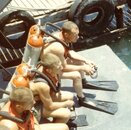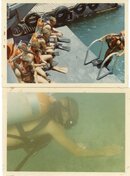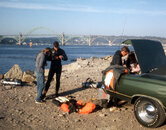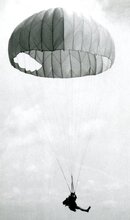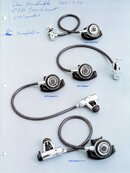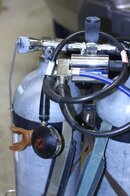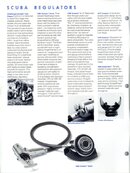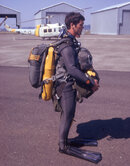This discussion has assumed that the J-valve was on a single tank, and in the past that was a single steel 72 cubic foot tank. But as I was trained in the U.S. Naval School for Underwater Swimmers (USS), and later as I served as a USAF Pararescueman, we dove double tanks. In the USS, we dove twin 90 cubic foot tanks (see the photos below of the grey cylinders). In the USAF, it was twin steel 72s and twin 42s (old 20-person life raft CO2 bottles). In both these cases, the J-valve was over one cylinder, and affected only that cylinder. If using a SPG on the regulator, it would not fluxuate, even though 500 psig was being "saved" in one of the two cylinders. When the first cylinder was empty, the second one would have 500 psig. Pulling the reserve allowed the two cylinders to equalize noisily (the buddy could hear it), and it would equalize at 250 psig. That, on a double cylinder scuba, was enough to allow a no-decompression ascent to the surface.
Now, if a diver used a J-valve reserve on a regulator, which is center-mounted on the twin cylinder rig, and without a J-valve on the manifold, it would be the equivalent of having a J-valve manifold with a 600 psig spring, and the center-mounted J-valve regulator would hold back 300 psig from both cylinders. In the USAF, up until the mid-1970s, we dove a single-hose regulator as a single hose regulator, no SPG, no octopus, no BCD inflator. We also jumped those smaller tanks parascuba, where we really did not want anything unnecessary to be hanging off the scuba as if we got twisted or tumbled by the air turbulance jumping out of a HC-130, for instance, it could tangle in the lines of the deploying parachute (see the photo of Pararescueman Rick Harder, below). Examples of these regulators were the Calypso-J, the Scubair-J, and the Sportsways Navy.
Now, the J-valve was not the only reserve mechanism used in vintage diving. There was also something called the "restricted orifice" reserve, which made breathing harder at low tank pressures. My first regulator, a Healthways Scuba double hose regulator, had this feature. My second regulator, a Healthways Scuba Star single hose regulator, also had this restrictor orifice inserted behind the sintered filter to warn me of low tank pressures. Healthways made another regulator, the Scubair, with a knob which would allow the diver to select either a restricted reserve (Auto-Reserve), or a J-valve setting if the tank had a J-valve on it (no restrictor orifice reserve). Finally, both Healthways and Scubapro came out with "sonic reserves," in which at low tank pressures the regulator would "sing," or give an audio warning that the diver was low on air. The Scubapro Mk VII was an example of this regulator, which would vibrate into the mouthpiece when low on air.
That's what we had in the early days of diving, and we did very well with those regulators. With both J-valves for single tanks, and my own J-valve for double hose regulators, we could mount the J-reserve on the opposite side so that it could not be knocked down if inadvertently hitting something too (see the photo of my twin 45s with a Sherwood manifold, reverse-mounted J-valve with a Scubapro Mk VII/Pilot regulator). With both the sonic reserve, and the J-valve manifold, there was some double security for diving. It was like having a 12.5 cubic foot pony bottle if the reserve was not pulled and the diver simply went by the sonic reserve.
SeaRat



